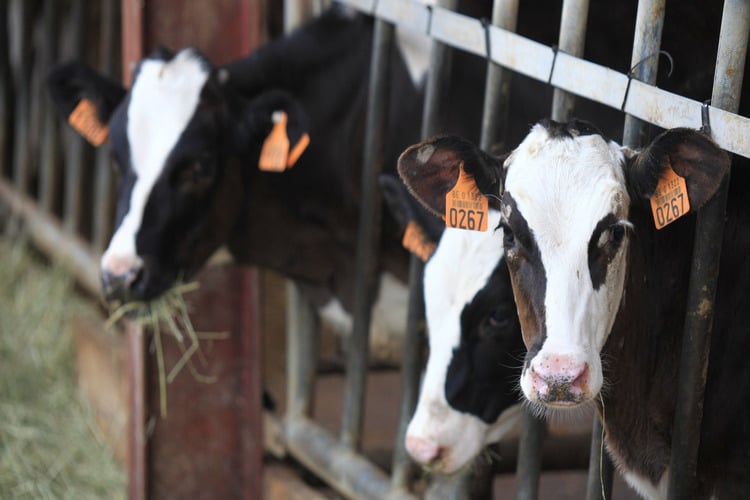Key takeaways from the research:
-
Adding forage to the pre-weaning diet of dairy calves increases pre-weaning growth.
-
Forage supplementation does not affect growth post-weaning but will help the transition from liquid feed to mixed diets.
-
Increased growth as a result of forage supplementation does have a positive effect on energy-corrected milk yield during the first lactation.

Forage supplementation increases pre-weaning growth and energy corrected milk yield in the first lactation
The two most important goals of heifer rearing for dairy producers are reducing the age at 1st calving and ensuring maximum lifetime production of milk. In order to optimize 1st lactation yield, reduced calving age should not come at the cost of reduced body weight[1]. It has been shown that improved growth of heifers under 6 months of age is associated with lower age at 1st calving[2] and a higher 1st lactation milk yield[3]. Pre-weaning average daily gain can be improved by increasing the level of pre-weaning nutrition, either through high levels of milk or calf milk replacer[4] or through forage supplementation if calves are fed lower levels of calf milk replacer[5]. Researchers from Barcelona[6] carried out a study in order to see if pre-weaning forage supplementation had positive effects on diet digestibility, reproduction, growth and milk yield.
Study design
Two groups of 30 female Holstein calves each were fed two different diets: The control calves (CON) were offered starter (19% crude protein, 19% neutral detergent fibre (NDF) during the pre-weaning period, followed by oats hay post-weaning. The second group of calves (OH) were offered the same starter as the CON calves, but oats hay was supplemented both pre-and post-weaning. All calves had access to water ad libitum and were initially offered 6 L/d calf milk replacer at 12% dry matter with a step-down weaning process beginning at 28 days until being fully weaned at day 52. From day 65 until three months of age, heifers were offered the same concentrate and forage as previously, ad libitum. Forage and concentrate intake were recorded daily and body weight was recorded weekly until day 65. Total tract apparent digestibility was determined two weeks after weaning. Bodyweight at 10 months of age, age at breeding and milk yield at 1st lactation were recorded.
Results
The OH calves had a higher pre-weaning average daily gain. This was related to a greater starter intake (20% more than CON calves). This resulted in 24% more growth for the OH calves in the pre-weaning phase. Post-weaning, while OH calves did consume more forage than CON calves and there was no difference in average daily gain or concentrate intake. There was no difference either between the two treatments in total tract apparent digestibility.
The results indicate that young dairy calves fed no forage pre-weaning adapt rapidly and are easily able to digest forage once offered. Additionally, although bodyweight in the OH group was greater at 65 days of age, the average daily gain from two weeks post-weaning through 10 months of age did not differ between the 2 groups. There was no significant difference between treatments either in reproductive performance or in 1st lactation milk yield or in milk solids yield, but the increase in average daily gain was positively correlated with energy corrected milk yield.
Adding hay to the pre-weaning diet of dairy calves increases pre-weaning growth and future performance
Offering forage to calves during the pre-weaning period does increase growth before weaning. Although this growth advantage was not maintained in the post-weaning period, offering forage could help in the transition to mixed diets. Additionally, the increase in average daily gain from 17 to 65 days of age was positively correlated with energy-corrected milk yield. The results of the current study are in line with findings from Soberon et al. [7] who found that 22% of 1st lactation milk production variation could be explained by pre-weaning growth rate. Adding forage to the pre-weaning diet will therefore have a positive impact on future performance.
References
[1] *Bach, A., and J. Ahedo. 2008. Record keeping and economics of dairy heifers. Vet. Clin. North Am. Food Anim. Pract. 24:117–138.
[2] * *Brickell, J. S., N. Bourne, M. M. McGowan, and D. C. Wathes. 2009. Effect of growth and development during the rearing period on the subsequent fertility of nulliparous Holstein-Friesian heifers. Theriogenology 72:408–416.
[3] *Soberon, F., E. Raffrenato, R. W. Everett, and M. E. Van Amburgh. 2012. Preweaning milk replacer intake and effects on long-term productivity of dairy calves. J. Dairy Sci. 95:783–793. And, Bach, A. 2012. Nourishing and managing the dam and postnatal calf for optimal lactation, reproduction, and immunity. J. Anim. Sci. 90:1835–1845.
[4] Raeth-Knight, M., H. Chester-Jones, S. Hayes, J. Linn, R. Larson, D. Ziegler, B. Ziegler, and N. Broadwater. 2009. Impact of conventional or intensive milk replacer programs on Holstein heifer performance through six months of age and during the first lactation. J. Dairy Sci. 92:799–809. And, Terré, M., M. Devant, and A. Bach. 2007. Effect of level of milk replacer fed to Holstein calves on performance during the preweaning period and starter digestibility at weaning. Livest. Sci. 110:82–88.
[5] *Castells, Ll., A. Bach, G. Araujo, C. Montoro, and M. Terré. 2012. Effect of different forage sources on performance and feeding behavior of Holstein calves. J. Dairy Sci. 95:286–293.
[6] *Castells, LI., A. Bach and M. Terré. 2015. Short- and long-term effects of forage supplementation of calves during the preweaning period on performance, reproduction, and milk yield at first lactation. J. Dairy Sci. 98: 1-6.
[7] Soberon et al., 2012. Op. cit.



